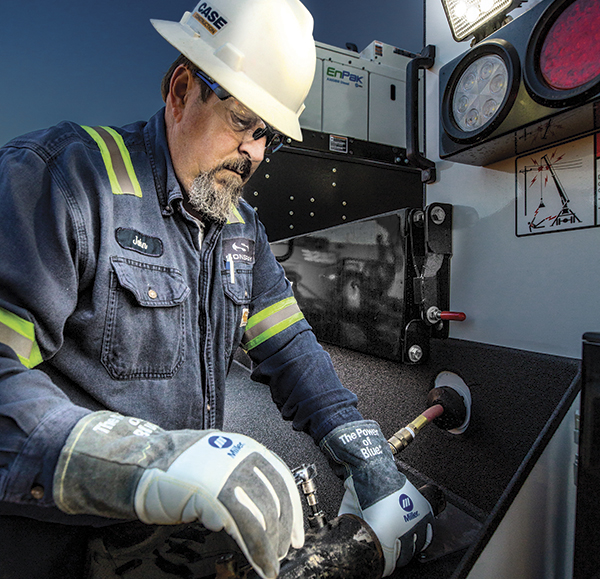A service tech’s safety, job satisfaction, and productivity are among the top priorities for most fleet managers. In order to achieve these objectives, you need to start by specifying a truck with the right accessories and equipment.
The choices you make when specifying the layout and design of a work truck will directly impact productivity and access, as well as technician well-being. Before your next service truck order, think about flexible equipment placement on the truck, adding steps and lighting for safety, and building in remote access to tools and equipment.
See how ergonomically designed equipment can improve service techs’ comfort and, ultimately, job satisfaction:
1 Reduce climbing in and out of the truck
For many truck fleets, one issue affecting technician comfort is the repetition of climbing in and out of the truck to get tools or change equipment settings. The more times a tech has to climb in and out of the truck, the longer it takes to complete a job, and the more chances there are for strain or injury. Choosing the right equipment and accessories that promote easy access helps reduce the risk of injury in addition to helping boost efficiency. Look for equipment that offers remote access or point-of-use controls so techs can spend less time walking back and forth or climbing in and out of the truck.
2 Easier access to equipment and accessories
Thoughtful truck and chassis design take into account a technician’s day-to-day work to promote ease of access and ergonomics. Well-placed handrails and steps on the back of the truck improve safety and security when technicians must climb in and out. Adequate lighting and non-slip surface coverings are smart add-ons that promote a better environment when techs are working in the dark or in rainy or icy conditions. There are many different designs and options available for these features, so it’s easy to choose one that bests fits your truck and technician needs. In addition, mounting equipment such as welder/generators or auxiliary power units lower on the truck so the controls are accessible from the ground also results in better access and reduced technician strain.
3 Less clutter on the truck and jobsite
A messy truck increases the likelihood of slips, trips, and falls, while an organized truck delivers advantages for technician efficiency. When techs can easily find the tools they need, they’re less stressed and can complete jobs faster. Look for opportunities to consolidate equipment in your truck fleet by choosing a tool that can do the job of many. For example, a welder/generator with additional capabilities like compressed air, battery charge, and even hydraulics helps reduce unnecessary equipment. This frees up payload space and reduces clutter while still ensuring space for the tools that techs need to get jobs done. There are also many design options for cabinets and shelving on a truck to help techs organize their tools and keep the truck tidy.
4 Easier maintenance and service
Some work truck equipment is designed for easy maintenance. For example, remote oil filter and drain kits for some truck accessories are designed specifically to keep techs off of the truck while still allowing access to the equipment from the ground. There are also closed oil-changed systems that eliminate the tech’s exposure to oil and keep trucks cleaner. Look for equipment with removable service panels and that have all service points on a single side of the machine. These features offer faster and easier access to the machine—reducing headaches and hassle for technicians when maintenance is needed. Staying on top of maintenance for the truck itself is also important for safety and efficiency. Keeping tires aired up and following a regular service schedule for the truck engine can help avoid breakdowns or poor vehicle performance.
5 Promote better habits
Telematics systems can provide a wide range of valuable truck and equipment data. While many fleets use telematics to track maintenance or manage fuel expenses, the data from these systems can also help alert you to certain habits or behaviors. For example, many telematics systems can be programmed to send speed alerts or provide information about harsh braking or acceleration. With this type of information fleets can implement training as needed for more efficient and safer practices.
SPEC FOR THE TECH
When service technicians are more comfortable and use equipment designed to improve access and convenience, it can improve your team’s productivity and results as well as boost job satisfaction and retention. There are endless innovative tips and ideas for building out your next work truck. Implement them, and see how equipment and accessory choices can boost technician comfort, ergonomics, and efficiency.
ABOUT THE AUTHOR
Cari Groppel is the market development manager at Miller Electric Mfg. LLC. Find out more, visit www.millerwelds.com.
_______________________________________________
MODERN WORKTRUCK SOLUTIONS:
JANUARY 2020 ISSUE
Did you enjoy this article?
Subscribe to the FREE Digital Edition of Modern WorkTruck Solutions magazine.




